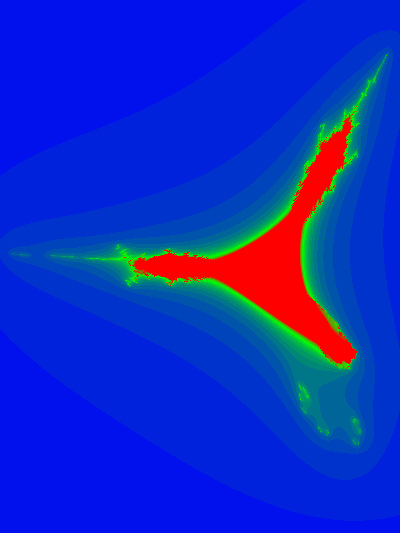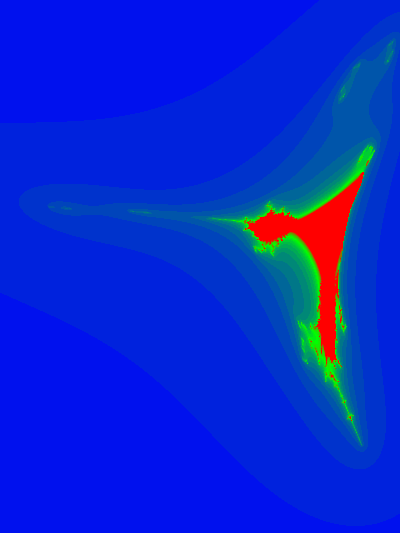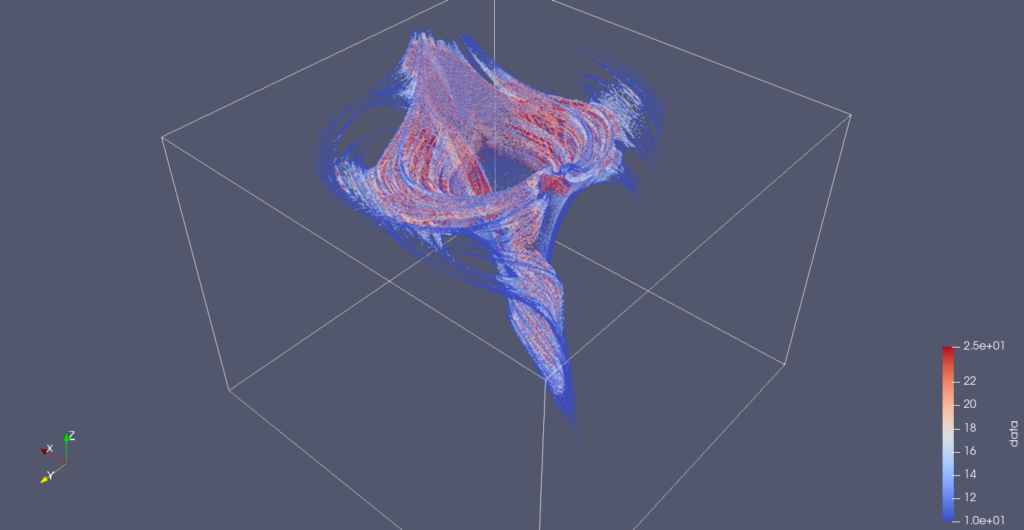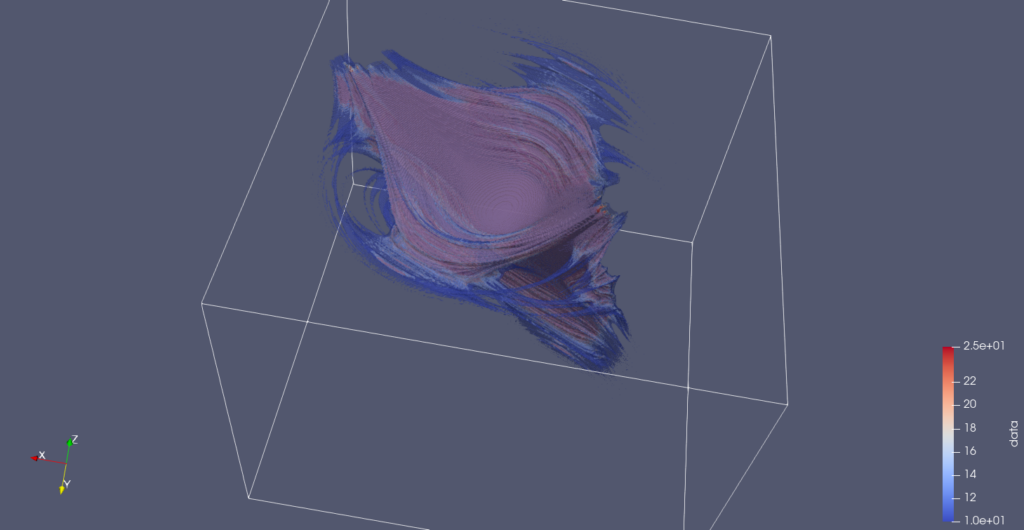[If mathjax doesn’t display properly for you, click here for a PDF of this post]
This is an exploration of the dyadic representation of the gradient acting on a vector in \(\mathbb{R}^3\), where we determine a tensor product formulation of a vector differential. Such a tensor product formulation can be split into symmetric and antisymmetric components. The geometric algebra (GA) equivalents of such a split are determined.
There is an error in part of the analysis below, which is addressed in a followup post made the next day.
GA gradient of a vector.
In GA we are free to express the product of the gradient and a vector field by adjacency. In coordinates (summation over repeated indexes assumed), such a product has the form
\begin{equation}\label{eqn:dyadicVsGa:20}
\spacegrad \Bv
= \lr{ \Be_i \partial_i } \lr{ v_j \Be_j }
= \lr{ \partial_i v_j } \Be_i \Be_j.
\end{equation}
In this sum, any terms with \( i = j \) are scalars since \( \Be_i^2 = 1 \), and the remaining terms are bivectors. This can be written compactly as
\begin{equation}\label{eqn:dyadicVsGa:40}
\spacegrad \Bv = \spacegrad \cdot \Bv + \spacegrad \wedge \Bv,
\end{equation}
or for \(\mathbb{R}^3\)
\begin{equation}\label{eqn:dyadicVsGa:60}
\spacegrad \Bv = \spacegrad \cdot \Bv + I \lr{ \spacegrad \cross \Bv},
\end{equation}
either of which breaks the gradient into into divergence and curl components. In \ref{eqn:dyadicVsGa:40} this vector gradient is expressed using the bivector valued curl operator \( (\spacegrad \wedge \Bv) \), whereas \ref{eqn:dyadicVsGa:60} is expressed using the vector valued dual form of the curl \( (\spacegrad \cross \Bv) \) from convential vector algebra.
It is worth noting that order matters in the GA coordinate expansion of \ref{eqn:dyadicVsGa:20}. It is not correct to write
\begin{equation}\label{eqn:dyadicVsGa:80}
\spacegrad \Bv
= \lr{ \partial_i v_j } \Be_j \Be_i,
\end{equation}
which is only true when the curl, \( \spacegrad \wedge \Bv = 0 \), is zero.
Dyadic representation.
Given a vector field \( \Bv = \Bv(\Bx) \), the differential of that field can be computed by chain rule
\begin{equation}\label{eqn:dyadicVsGa:100}
d\Bv = \PD{x_i}{\Bv} dx_i = \lr{ d\Bx \cdot \spacegrad} \Bv,
\end{equation}
where \( d\Bx = \Be_i dx_i \). This is a representation invariant form of the differential, where we have a scalar operator \( d\Bx \cdot \spacegrad \) acting on the vector field \( \Bv \). The matrix representation of this differential can be written as
\begin{equation}\label{eqn:dyadicVsGa:120}
d\Bv = \lr{
{\begin{bmatrix}
d\Bx
\end{bmatrix}}^\dagger
\begin{bmatrix}
\spacegrad
\end{bmatrix}
}
\begin{bmatrix}
\Bv
\end{bmatrix}
,
\end{equation}
where we are using the dagger to designate transposition, and each of the terms on the right are the coordinate matrixes of the vectors with respect to the standard basis
\begin{equation}\label{eqn:dyadicVsGa:140}
\begin{bmatrix}
d\Bx
\end{bmatrix}
=
\begin{bmatrix}
dx_1 \\
dx_2 \\
dx_3
\end{bmatrix},\quad
\begin{bmatrix}
\Bv
\end{bmatrix}
=
\begin{bmatrix}
v_1 \\
v_2 \\
v_3
\end{bmatrix},\quad
\begin{bmatrix}
\spacegrad
\end{bmatrix}
=
\begin{bmatrix}
\partial_1 \\
\partial_2 \\
\partial_3
\end{bmatrix}.
\end{equation}
In \ref{eqn:dyadicVsGa:120} the parens are very important, as the expression is meaningless without them. With the parens we have a \((1 \times 3)(3 \times 1)\) matrix (i.e. a scalar) multiplied with a \(3\times 1\) matrix. That becomes ill-formed if we drop the parens since we are left with an incompatible product of a \((3\times1)(3\times1)\) matrix on the right. The dyadic notation, which introducing a tensor product into the mix, is a mechanism to make sense of the possibility of such a product. Can we make sense of an expression like \( \spacegrad \Bv \) without the geometric product in our toolbox?
Stepping towards that question, let’s examine the coordinate expansion of our vector differential \ref{eqn:dyadicVsGa:100}, which is
\begin{equation}\label{eqn:dyadicVsGa:160}
d\Bv = dx_i \lr{ \partial_i v_j } \Be_j.
\end{equation}
If we allow a matrix of vectors, this has a block matrix form
\begin{equation}\label{eqn:dyadicVsGa:180}
d\Bv =
{\begin{bmatrix}
d\Bx
\end{bmatrix}}^\dagger
\begin{bmatrix}
\spacegrad \otimes \Bv
\end{bmatrix}
\begin{bmatrix}
\Be_1 \\
\Be_2 \\
\Be_3
\end{bmatrix}
.
\end{equation}
Here we introduce the tensor product
\begin{equation}\label{eqn:dyadicVsGa:200}
\spacegrad \otimes \Bv
= \partial_i v_j \, \Be_i \otimes \Be_j,
\end{equation}
and designate the matrix of coordinates \( \partial_i v_j \), a second order tensor, by \(
\begin{bmatrix}
\spacegrad \otimes \Bv
\end{bmatrix}
\).
We have succeeded in factoring out a vector gradient. We can introduce dot product between vectors and a direct product of vectors, by observing that \ref{eqn:dyadicVsGa:180} has the structure of a quadradic form, and define
\begin{equation}\label{eqn:dyadicVsGa:220}
\Bx \cdot (\Ba \otimes \Bb) \equiv
{\begin{bmatrix}
\Bx
\end{bmatrix}}^\dagger
\begin{bmatrix}
\Ba \otimes \Bb
\end{bmatrix}
\begin{bmatrix}
\Be_1 \\
\Be_2 \\
\Be_3
\end{bmatrix},
\end{equation}
so that \ref{eqn:dyadicVsGa:180} takes the form
\begin{equation}\label{eqn:dyadicVsGa:240}
d\Bv = d\Bx \cdot \lr{ \spacegrad \otimes \Bv }.
\end{equation}
Such a dot product gives operational meaning to the gradient-vector tensor product.
Symmetrization and antisymmetrization of the vector differential in GA.
Using the dyadic notation, it’s possible to split a vector derivative into symmetric and antisymmetric components with respect to the gradient-vector direct product
\begin{equation}\label{eqn:dyadicVsGa:260}
d\Bv
= d\Bx \cdot
\lr{
\inv{2} \lr{ \spacegrad \otimes \Bv + \lr{ \spacegrad \otimes \Bv }^\dagger }
+
\inv{2} \lr{ \spacegrad \otimes \Bv – \lr{ \spacegrad \otimes \Bv }^\dagger }
},
\end{equation}
or \( d\Bv = d\Bx \cdot \lr{ \Bd + \BOmega } \), where \( \Bd \) is a symmetric tensor, and \( \BOmega \) is a traceless antisymmetric tensor.
A question of potential interest is “what GA equvivalent of this expression?”. There are two identities that are helpful for extracting this equivalence, the first of which is the k-blade vector product identities. Given a k-blade \( B_k \) (i.e.: a product of \( k \) orthogonal vectors, or the wedge of \( k \) vectors), and a vector \( \Ba \), the dot product of the two is
\begin{equation}\label{eqn:dyadicVsGa:280}
B_k \cdot \Ba = \inv{2} \lr{ B_k \Ba + (-1)^{k+1} \Ba B_k }
\end{equation}
Specifically, given two vectors \( \Ba, \Bb \), the vector dot product can be written as a symmetric sum
\begin{equation}\label{eqn:dyadicVsGa:300}
\Ba \cdot \Bb = \inv{2} \lr{ \Ba \Bb + \Bb \Ba } = \Bb \cdot \Ba,
\end{equation}
and given a bivector \( B \) and a vector \( \Ba \), the bivector-vector dot product can be written as an antisymmetric sum
\begin{equation}\label{eqn:dyadicVsGa:320}
B \cdot \Ba = \inv{2} \lr{ B \Ba – \Ba B } = – \Ba \cdot B.
\end{equation}
We may apply these to expressions where one of the vector terms is the gradient, but must allow for the gradient to act bidirectionally. That is, given multivectors \( M, N \)
\begin{equation}\label{eqn:dyadicVsGa:340}
M \spacegrad N
=
\partial_i (M \Be_i N)
=
(\partial_i M) \Be_i N + M \Be_i (\partial_i N),
\end{equation}
where parens have been used to indicate the scope of applicibility of the partials. In particular, this means that we may write the divergence as a GA symmetric sum
\begin{equation}\label{eqn:dyadicVsGa:360}
\spacegrad \cdot \Bv = \inv{2} \lr{
\spacegrad \Bv + \Bv \spacegrad },
\end{equation}
which clearly corresponds to the symmetric term \( \Bd = (1/2) \lr{ \spacegrad \otimes \Bv + \lr{ \spacegrad \otimes \Bv }^\dagger } \) from \ref{eqn:dyadicVsGa:260}.
Let’s assume that we can write our vector differential in terms of a divergence term isomorphic to the symmetric sum in \ref{eqn:dyadicVsGa:260}, and a “something else”, \(\BX\). That is
\begin{equation}\label{eqn:dyadicVsGa:380}
\begin{aligned}
d\Bv
&= \lr{ d\Bx \cdot \spacegrad } \Bv \\
&= d\Bx (\spacegrad \cdot \Bv) + \BX,
\end{aligned}
\end{equation}
where
\begin{equation}\label{eqn:dyadicVsGa:400}
\BX = \lr{ d\Bx \cdot \spacegrad } \Bv – d\Bx (\spacegrad \cdot \Bv),
\end{equation}
is a vector expression to be reduced to something simpler. That reduction is possible using the distribution identity
\begin{equation}\label{eqn:dyadicVsGa:420}
\Bc \cdot (\Ba \wedge \Bb)
=
(\Bc \cdot \Ba) \Bb
– (\Bc \cdot \Bb) \Ba,
\end{equation}
so we find
\begin{equation}\label{eqn:dyadicVsGa:440}
\BX = \spacegrad \cdot \lr{ d\Bx \wedge \Bv }.
\end{equation}
We find the following GA split of the vector differential into symmetric and antisymmetric terms
\begin{equation}\label{eqn:dyadicVsGa:460}
\boxed{
d\Bv
= (d\Bx \cdot \spacegrad) \Bv
= d\Bx (\spacegrad \cdot \Bv)
+
\spacegrad \cdot \lr{ d\Bx \wedge \Bv }.
}
\end{equation}
Such a split avoids the indeterminant nature of the tensor product, which we only give meaning by introducing the quadratic form based dot product given by \ref{eqn:dyadicVsGa:220}.
Like this:
Like Loading...





